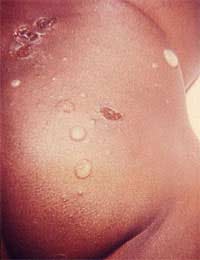What is Impetigo?

Impetigo is the medical term for a skin infection caused by the bacterium Staphylococcus aureus. Some rare types of impetigo can also be due to Streptococcus pyogenes. The infection is not serious or life threatening but it can spread very easily from person to person. It is very common in children at playgroups, nursery school and primary school and can be passed on by playing and social contact.
The impetigo starts with one or two spots on the skin that become larger until they are about 1cm in diameter. They look like blisters but rapidly fill with yellow pus. The surface breaks up, leaving a crusty scab after a few days. The lesions are very often itchy and scratching the skin increases the risk that the infection will spread to other parts of the skin in the affected child, and that it will pass to other children. The bacteria that are actively growing in the scabs and blisters get under the fingernails and onto toys, surfaces, towels and other objects that are used by others.
Who Is At Risk of Impetigo?
Young children generally, but those who have an underlying skin condition such as eczema are particularly prone to developing impetigo. The skin is already itchy and scratching can break the skin and introduce Staphylococcus aureus, which is often carried on the skin as a commensal bacteria (one that is usually harmless), into the wound. Once the skin is broken, Staphylococcus aureus becomes an opportunistic pathogen. It starts to grow in the broken area of skin and sets up a local infection. The pus that forms contains lots of dead bacteria and immune cells that come to the area to fight off the infection. In children with eczema, healing is slower and the condition can recur unless the underlying condition is kept under control.Treatments
As impetigo is not a serious skin condition, the usual treatment is to keep the child off school for a few days to prevent the infection spreading to others, and to wash the skin with soap and allow the air to dry out the infected lesions. This is usually enough to help the body’s own immune system deal with the infection successfully. If eczema is present, a GP may prescribe ointment or cream containing antibiotics such as fusidic acid to speed up clearance of the Staphylococcus or Streptococcus bacteria.For severe cases, where large areas of skin have become infected, or the infection is not clearing as quickly as it should, antibiotics that are taken by mouth are prescribed. The usual ones are amoxicillin and erythromycin, and these are available in liquid form for very young children.


Re: Friendly Bacteria in the Digestive System
poo transplants in sketchy alleyway tonight
Re: Friendly Bacteria in the Digestive System
hello, thankyou for this website it was very helpful
Re: Friendly Bacteria in the Digestive System
nope im leaving now goodbye , mumm! crimble crumble ready?
Re: Friendly Bacteria in the Digestive System
The meat out of the bin is perfectly fine jackie!
Re: Friendly Bacteria in the Digestive System
Yeahhh jim not the right time were quite busy at the moment
Re: How Can People Catch Lyme Disease?
My symptoms of Lyme disease occurred in 2017, but was diagnosed in 2019. I had severe symptoms ranging from headache,…
Re: Friendly Bacteria in the Digestive System
giving away free plastic surgery
Re: Friendly Bacteria in the Digestive System
hey queens im coming out >3
Re: Friendly Bacteria in the Digestive System
uwu
Re: Friendly Bacteria in the Digestive System
t rg dvfcgbvew